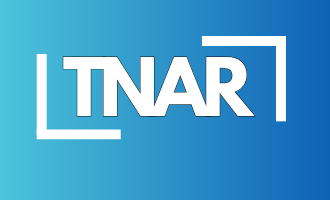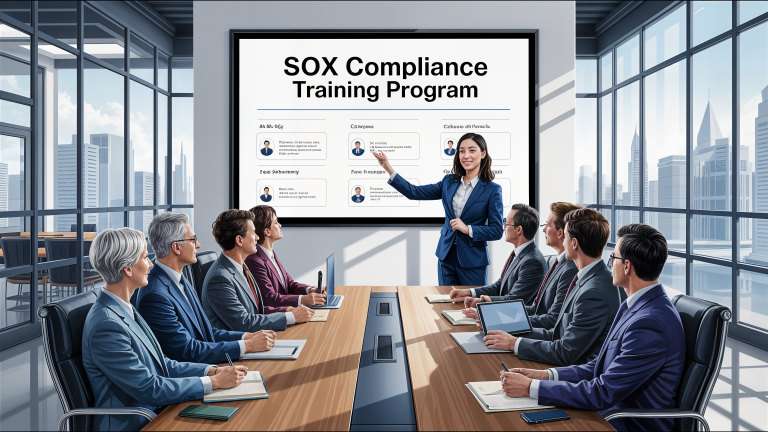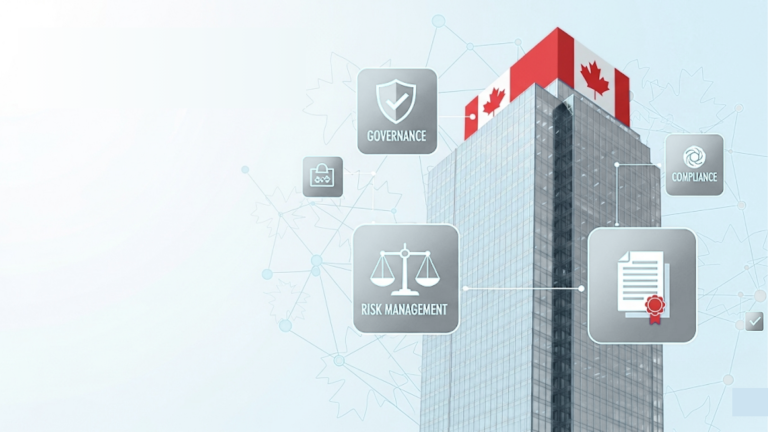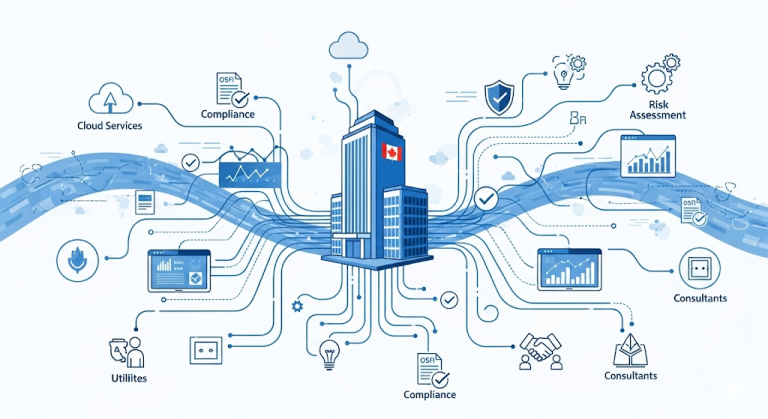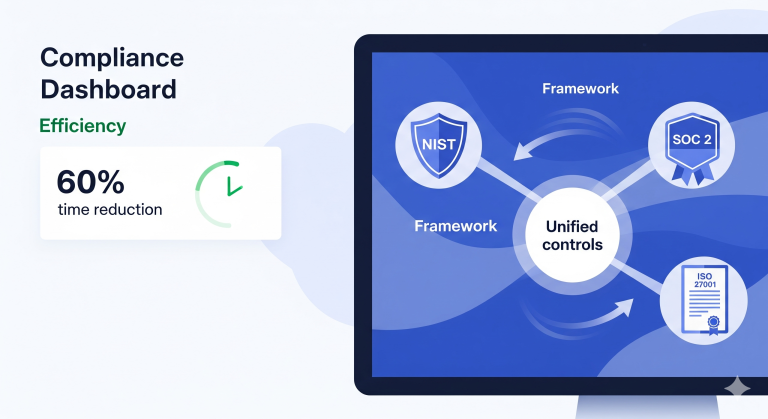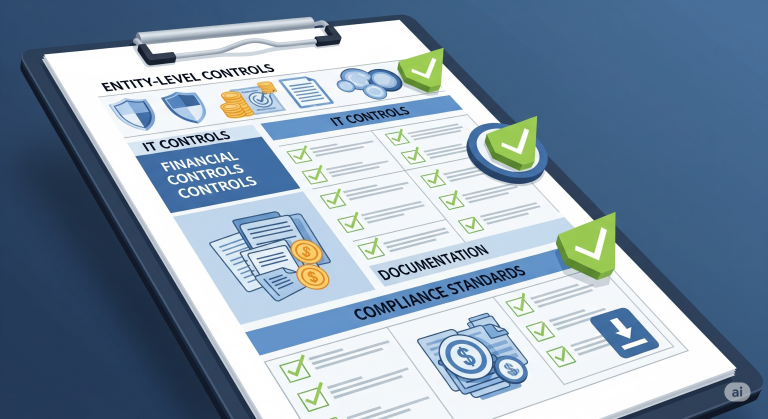Nearly 70% of service organizations reported the necessity to demonstrate compliance or conformity to at least six different frameworks covering information security and data privacy in 2023, according to Zluri’s comprehensive compliance statistics report. This complexity leaves many business leaders confused about which specific compliance framework their organization actually needs.
The confusion between SOC 2 vs SOX compliance costs businesses significant time and resources. While both frameworks address internal controls, they serve entirely different purposes and apply to different types of organizations. Understanding which framework your business needs—or whether you need both—is crucial for making informed compliance investments.
Whether you’re a growing SaaS company facing enterprise sales obstacles or a private company preparing for public markets, this guide will help you determine the right compliance path for your business. For comprehensive implementation guidance once you’ve made your decision, explore our complete SOC compliance guide for detailed strategies and best practices.
Quick Answer: Do You Need SOC 2 or SOX? (Business Qualifier)
Take this 30-second assessment to determine your compliance needs:
You likely need SOX compliance if:
- Your company is publicly traded on US exchanges
- You’re a foreign company listed on US stock exchanges
- You’re a subsidiary of a publicly traded company
- You’re preparing for an IPO within the next 12-18 months
- You’re being acquired by a public company
You likely need SOC 2 compliance if:
- You’re a SaaS or technology service provider
- Enterprise clients are requesting security certifications
- You handle, store, or process customer data
- You’re facing vendor security questionnaires
- Your sales process stalls due to security concerns
Red flags that indicate immediate compliance needs:
- Enterprise deals requiring security attestations
- Customer security questionnaires becoming more frequent
- Investor due diligence requests for compliance frameworks
- Regulatory inquiries about your internal controls
If you answered “yes” to multiple SOX criteria, SOX compliance is likely mandatory for your organization. If you answered “yes” to SOC 2 criteria, this framework could unlock significant business opportunities and address customer security concerns.
What is SOX Compliance? (Who Must Comply)
SOX compliance refers to adherence to the Sarbanes-Oxley Act of 2002, a federal law requiring publicly traded companies to maintain accurate financial reporting and robust internal controls.
SOX compliance is mandatory for:
- US publicly traded companies: All companies listed on major US stock exchanges (NYSE, NASDAQ)
- Foreign companies on US exchanges: International companies with American Depositary Receipts (ADRs)
- Public company subsidiaries: Wholly-owned subsidiaries that impact parent company financial reporting
- Pre-IPO companies: Private companies actively preparing for public offerings
Key trigger events requiring SOX compliance:
- Completing an initial public offering (IPO)
- Being acquired by a publicly traded company
- Reaching certain size thresholds as a public company subsidiary
- Filing financial statements with the Securities and Exchange Commission (SEC)
Important note for private companies: SOX compliance is not required for private companies, regardless of size or revenue. However, many private companies implement SOX-like controls to prepare for eventual public offerings or to demonstrate strong governance to investors.
The penalties for SOX non-compliance are severe, including criminal charges for executives, substantial fines, and potential delisting from stock exchanges. This makes SOX compliance a legal necessity rather than a business choice for applicable companies.
What is SOC 2 Compliance? (Who Should Consider It)
SOC 2 compliance is a voluntary cybersecurity framework developed by the American Institute of Certified Public Accountants (AICPA) that evaluates how service organizations handle customer data and maintain system security.
SOC 2 compliance is ideal for:
- SaaS and cloud service providers: Companies offering software or infrastructure as a service
- Technology vendors: Organizations providing technology solutions to other businesses
- Data processors: Companies handling sensitive customer information
- Business process outsourcing (BPO) providers: Organizations managing business functions for clients
The five Trust Service Criteria evaluated in SOC 2:
- Security: Protection against unauthorized access
- Availability: System accessibility for operation and use
- Processing Integrity: Complete, valid, accurate, and authorized system processing
- Confidentiality: Protection of confidential information
- Privacy: Personal information collection, use, retention, and disposal practices
Business triggers indicating SOC 2 need:
- Enterprise sales prospects requesting security certifications
- Lengthy vendor security questionnaires slowing sales cycles
- Customer contracts requiring third-party security attestations
- Competitive disadvantage due to lack of security certifications
- Insurance requirements for cyber liability coverage
While SOC 2 compliance is voluntary, it has become a market expectation for service providers handling sensitive data. Many enterprise customers will not engage vendors without SOC 2 attestation, making it essential for business growth rather than regulatory compliance.
5 Key Business Factors: SOC 2 vs SOX Decision Criteria
Factor 1: Legal Requirements vs Market Expectations
SOX: Legally mandated for public companies with criminal penalties for non-compliance. Corporate executives can face up to 20 years in prison for fraudulent financial reporting.
SOC 2: Voluntary framework driven by market demands. No legal penalties for non-compliance, but potential loss of business opportunities.
Decision point: If your company is publicly traded or preparing for IPO, SOX is non-negotiable. If you’re selling services to other businesses, SOC 2 addresses customer security requirements.
Factor 2: Business Model and Revenue Sources
SOX focus: Investor protection through accurate financial reporting. Designed for companies with public shareholders requiring transparency.
SOC 2 focus: Customer data protection and operational security. Designed for service providers needing to demonstrate trustworthy operations.
Decision point: Public companies with investors need SOX. Service providers with enterprise customers need SOC 2.
Factor 3: Customer Base and Sales Requirements
SOX requirements typically come from:
- SEC regulations and stock exchange listing requirements
- Investor demands for financial transparency
- Audit firm requirements for annual assessments
SOC 2 requirements typically come from:
- Enterprise customer procurement processes
- Vendor risk management programs
- Insurance and contractual obligations
Decision point: Listen to your customers and stakeholders. If enterprise clients are asking for security certifications, pursue SOC 2. If investors are demanding financial controls, SOX may be necessary.
Factor 4: Company Stage and Growth Plans
SOX timing considerations:
- Required within 12-15 months of going public
- Should begin 18-24 months before planned IPO
- Ongoing annual requirements with external audits
SOC 2 timing considerations:
- Can be pursued at any business stage
- Typically implemented when facing enterprise sales obstacles
- Provides competitive advantage in vendor selection processes
Decision point: Align compliance efforts with business milestones. IPO companies should prioritize SOX preparation. Growth-stage service providers should consider SOC 2 for market expansion.
Factor 5: Industry and Regulatory Environment
Industries commonly requiring SOX:
- Financial services (banks, investment firms)
- Healthcare (public companies only)
- Technology (public SaaS companies)
- Manufacturing (large public companies)
Industries commonly pursuing SOC 2:
- Software as a Service (SaaS)
- Cloud infrastructure providers
- Healthcare technology
- Financial technology (fintech)
Decision point: Industry norms and customer expectations often dictate compliance needs. Research what your competitors and industry leaders have implemented.
Cost and Timeline Reality Check: What to Expect
SOX Compliance Investment
Initial implementation costs:
- Small public companies (under $1B revenue): $500K – $1.5M
- Mid-market companies ($1B – $5B revenue): $1.5M – $3M
- Large companies (over $5B revenue): $3M – $8M+
Annual ongoing costs:
- External audit fees: $200K – $800K annually
- Internal resources: 5,000 – 15,000 hours annually
- Technology and consultants: $100K – $500K annually
Implementation timeline: 12-18 months for initial compliance, ongoing annual requirements
SOC 2 Compliance Investment
Initial implementation costs:
- Startups (under 50 employees): $25K – $75K
- Growth companies (50-250 employees): $50K – $150K
- Mid-market companies (250+ employees): $100K – $300K
Annual ongoing costs:
- Annual audit fees: $15K – $50K
- Internal resources: 500 – 2,000 hours annually
- Technology and maintenance: $10K – $50K annually
Implementation timeline: 6-12 months for initial compliance, annual or bi-annual assessments
Return on Investment Considerations
SOX ROI factors:
- Reduced cost of capital through improved investor confidence
- Lower insurance premiums for directors and officers coverage
- Enhanced ability to attract institutional investors
- Reduced risk of regulatory penalties and legal issues
SOC 2 ROI factors:
- Faster enterprise sales cycles (30-50% reduction in security review time)
- Higher win rates for competitive deals requiring security certifications
- Premium pricing opportunities for security-conscious customers
- Reduced cyber insurance premiums
Cost optimization strategies:
- Leverage shared service providers for audit and consulting
- Implement technology platforms that support multiple frameworks
- Coordinate compliance efforts to maximize resource efficiency
- Start compliance programs early to spread costs over longer periods
Common Business Scenarios: Real Examples
Scenario 1: SaaS Startup Hitting Enterprise Sales Wall
Situation: A 75-employee marketing automation SaaS company with $8M ARR was consistently losing enterprise deals in final stages due to security concerns.
Challenge: Enterprise prospects required security certifications that the company couldn’t provide. Sales cycles were extending from 3 months to 8+ months due to extensive security questionnaires.
Solution: Implemented SOC 2 Type II compliance over 8 months.
Outcome:
- 40% reduction in enterprise sales cycle length
- 25% increase in deal closure rate for enterprise opportunities
- $2.3M in additional revenue within 12 months
- Enhanced ability to compete against larger, established vendors
Scenario 2: Private Company Preparing for IPO
Situation: A $150M revenue healthcare technology company planning IPO in 18 months discovered significant internal control gaps during initial assessments.
Challenge: Existing financial reporting processes were insufficient for public company requirements. No formal SOX compliance program existed.
Solution: Implemented comprehensive SOX compliance program 20 months before planned IPO date.
Outcome:
- Successful IPO with no compliance-related delays
- Improved investor confidence demonstrated through roadshow presentations
- Reduced ongoing compliance costs through early implementation
- Established foundation for post-IPO audit requirements
Scenario 3: Service Provider Acquired by Public Company
Situation: A 200-employee cloud infrastructure provider was acquired by a publicly traded technology company.
Challenge: As a new subsidiary, the company needed both SOC 2 (for customer requirements) and SOX compliance (for parent company financial reporting).
Solution: Implemented integrated compliance program addressing both frameworks simultaneously.
Outcome:
- Streamlined audit processes by coordinating SOC 2 and SOX assessments
- Reduced total compliance costs by 30% through shared resources
- Maintained customer confidence through continued SOC 2 compliance
- Met parent company SOX requirements within required timeframes
Scenario 4: Technology Vendor with Government Clients
Situation: A cybersecurity software company with mixed commercial and government clients faced varying compliance requirements.
Challenge: Government clients required FedRAMP compliance, while commercial enterprise clients required SOC 2. Neither required SOX.
Solution: Prioritized SOC 2 compliance as foundation, then built additional controls for FedRAMP.
Outcome:
- SOC 2 compliance satisfied most commercial enterprise requirements
- Used SOC 2 as stepping stone to more complex government compliance
- Expanded addressable market to include both sectors
- Developed expertise in multiple compliance frameworks
Scenario 5: Private Equity-Backed Company Growth Strategy
Situation: A private equity firm acquired a $50M revenue fintech company with plans for aggressive growth and eventual exit.
Challenge: Growth strategy required both enterprise customer acquisition and preparation for potential IPO exit.
Solution: Implemented SOC 2 immediately for market expansion, with SOX readiness planning for future IPO option.
Outcome:
- SOC 2 compliance enabled expansion into enterprise financial services market
- Pre-planning for SOX reduced future implementation timeline and costs
- Increased company valuation through demonstrated governance capabilities
- Provided multiple exit options (strategic sale or IPO)
Your Next Steps: Making the Decision and Moving Forward
Decision Summary and Action Plan
Based on your assessment of the five key factors, you should now have clarity on which compliance framework applies to your business situation.
If you determined SOX compliance is necessary:
- Immediate actions: Engage experienced SOX consultants for gap assessment
- Timeline planning: Allow 12-18 months for initial compliance implementation
- Budget allocation: Reserve $500K-$3M+ depending on company size
- Team preparation: Identify internal SOX program manager and cross-functional team
- Audit planning: Begin auditor selection process for annual requirements
If you determined SOC 2 compliance is the priority:
- Immediate actions: Conduct SOC 2 readiness assessment to identify control gaps
- Timeline planning: Plan 6-12 month implementation for initial certification
- Budget allocation: Reserve $25K-$300K depending on company size and complexity
- Team preparation: Assign internal SOC 2 project lead and security team
- Vendor selection: Research and select qualified CPA firms for audit services
If you need both frameworks:
- Coordination strategy: Implement integrated compliance program with shared resources
- Prioritization: Begin with most business-critical framework based on immediate needs
- Resource optimization: Leverage overlapping controls and documentation where possible
- Phased approach: Stagger implementation to manage resource constraints effectively
Implementation Planning Considerations
Team roles and responsibilities:
- Executive sponsor: C-level champion for compliance initiative
- Program manager: Day-to-day coordination and project management
- IT security lead: Technical implementation and security controls
- Finance lead: Financial reporting controls and audit coordination
- Legal counsel: Regulatory interpretation and contract implications
Technology requirements:
- Governance, Risk, and Compliance (GRC) platforms for control management
- Security tools for continuous monitoring and evidence collection
- Documentation systems for policy and procedure management
- Audit management software for assessment coordination
Vendor selection criteria:
- Audit firms: Look for relevant industry experience and framework expertise
- Consultants: Prioritize implementation experience over pure advisory
- Technology vendors: Ensure platforms support your specific compliance requirements
- Training providers: Invest in team education for sustainable compliance programs
Getting Started Today
Week 1-2: Assessment and planning
- Complete comprehensive compliance readiness assessment
- Define project scope, timeline, and budget parameters
- Identify key stakeholders and form project team
- Begin vendor research and request for proposal process
Month 1: Foundation building
- Conduct detailed gap analysis against chosen framework requirements
- Develop project plan with milestones and deliverables
- Select primary vendors (auditors, consultants, technology)
- Establish governance structure and reporting mechanisms
Month 2-3: Implementation launch
- Begin control design and documentation efforts
- Implement required technology platforms and security tools
- Start employee training and awareness programs
- Establish ongoing monitoring and measurement processes
Ongoing: Continuous improvement
- Regular progress reviews against project milestones
- Quarterly risk assessments and control effectiveness testing
- Annual compliance program evaluation and optimization
- Stay current with framework updates and industry best practices
The key to successful compliance implementation is starting with clear business objectives, assembling the right team, and maintaining executive commitment throughout the process. Whether you choose SOC 2 vs SOX, or both, the investment in robust compliance programs delivers measurable business value beyond regulatory requirements.
For comprehensive guidance on implementing your chosen compliance framework, including detailed control requirements, implementation strategies, and best practices, explore our complete SOC compliance guide for step-by-step implementation support and expert insights.
